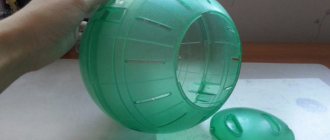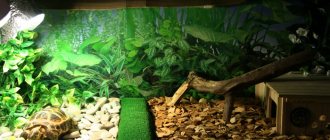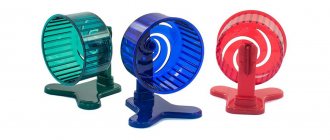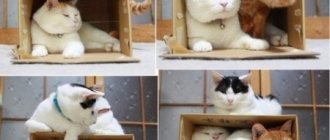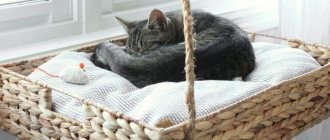The question of how to make a house for a hamster with your own hands at home is faced by the owner even before purchasing the animal. His decision depends on the size of the animal. The Dzungarians need a house less than the Syrians. This matter should not be put off until a later date, since the animal needs shelter in the first minutes of being in a new place. If time is running out, make a temporary shelter out of paper or cardboard.
What can you make a hamster house from?
The purpose of the house is to shelter the kids from prying eyes. The manufacturing material must be non-toxic, since the hamster will definitely taste it. The house will have to be cleaned; the animal should feel comfortable in it. The animal itself will show how it feels in it, having settled in a new nest.
Craftsmen make houses from cardboard and paper. Adapted for this: coconut shells, ready-made boxes, wooden planks and slats, plywood, toilet paper rollers and even popsicle sticks.
Rules for arranging a home for a hamster
For large breeds of hamsters, carefully choose a cage so that the holes in it correspond to the size of the animal, otherwise it risks getting stuck in them.
Simple tips for creating a cozy place for your hamster inside the cage:
- Napkins or torn paper can serve as a house, from which the pet will make a nest for itself.
- Pieces of non-woolen fabric are placed in the house.
- You can buy ready-made nesting material for rodents.
- Periodically it is necessary to clean the hamster's house, and at the same time clear it of old food supplies.
Your pet feels more comfortable having a secluded place where they can retire.
Paper house for Djungarian hamster
This temporary house will not last long. Some animals deal with it in one night. Its advantages: minimal costs and fast production. For this design you will need: toilet paper, a bowl of water and a balloon.
The procedure is as follows:
- inflate the balloon to the size of a large apple;
- Divide the toilet paper into separate sheets and moisten with water;
- stick the sheets onto the ball until about 8 layers are formed on it;
- send the structure to dry on the battery;
- pierce the ball with a needle or simply deflate;
- remove the balloon from the paper frame;
- Make an entrance for the hamster in the paper frame.
The room will resemble a hemisphere. This house is suitable for a dwarf hamster. It is short-lived and fragile.
The need to create a cozy environment for the hamster
Despite the fact that a hamster really looks like a fluffy toy, in fact it is a very fragile creature that needs careful treatment and care.
With a sedentary lifestyle, Djungarians are prone to obesity. That is why pet stores offer a wide range of different accessories that make animals move more. These are various labyrinths, tunnels, stairs, swings, running wheels. However, you can also make all sorts of things for hamsters from cardboard with your own hands.
Most often, DIY hamster crafts are made for 2 purposes:
- stimulating animal activity;
- search for treats.
The dimensions of the crafts must match the animal so that it can move freely without getting stuck between the structural elements.
Examples of ready-made cardboard crafts
Options for ready-made homemade products will help you choose an interesting idea of what can be made from cardboard for a hamster, how to decorate your pet’s home in an interesting way, design toys and objects that encourage the hamster to be active.
a maze for a hamster made of cardboard with built-in ladders, tunnels, and slides.
Running wheel made of corrugated cardboard.
A two-story cardboard house for a hamster, made using decorative paper.
Balls made from cardboard tubes with treats inside.
Tunnels made of bushings with slots for active crawling and searching for food.
A small cardboard house that looks like a real one.
Cardboard furniture.
Coconut shell hamster house
This design is more durable than the previous version. Despite the apparent simplicity of production, you will have to tinker with it for several hours, scraping the pulp out of the fruit. The dwelling turns out to be quite small, so it will serve as a shelter for the Djungarian hamster. Select a coconut and get to work:
You can stop there, but the home will turn out to be unstable and will roll around the cage. To avoid this, install the coconut house with the cut hole down.
On one side, draw a small arch and cut it along the contour. Sand the edges. This will be the entrance to the house. Drill holes for ventilation. If desired, you can make decorative windows on the side.
Possible problems and ways to solve them
With all its positive qualities, the hamster can hardly be called the smartest of all pets. This animal is less trainable than its larger “competitors,” needs communication, and shows a willingness to do what is expected of it.
For this reason, you should always be prepared for the fact that a house lovingly built for a rodent will not be used “for its intended purpose.” However, do not despair, perhaps the problem can be solved.
Hamster doesn't sleep in the house
There may be several reasons for a hamster’s refusal to accept the “living space” provided at its disposal:
- The material from which the house is made, or the bedding placed inside, causes allergies in the animal or causes it other inconveniences (unpleasant odor, uncomfortable texture, sharp edges, etc.). Analyze what raw materials you used and, if possible, correct the mistake.
- The animal did not understand the purpose of the new design. Perhaps it is worth trying to place some object inside the home that has a familiar aroma, and the inhabitant will change his opinion about the strange design.
- The hamster uses the room as a warehouse for storing supplies and there is simply no room left for him to stay inside. In this case, it is worth thinking about a more spacious home or a second house (it is not at all necessary that there be one).
- The exit from the room is too narrow , and it is uncomfortable for the animal to perform complex maneuvers every time.
- The opposite reason: the exit is located in such a way that the animal simply has nowhere to hide inside, and it is forced to look for more secluded corners in the cage.
- Lack of ventilation if the home is not designed correctly can make it too hot and stuffy. Think about how to add additional windows to your house.
- Housing is too cramped. If there is no room for the hamster to move inside the house, he is unlikely to choose it for rest. The dimensions of the structure must be compared with the dimensions of the resident.
If all the mentioned reasons are excluded, and the hamster still stubbornly refuses to live in the house, you should probably leave the animal alone, giving it the right to independently choose a place to spend time. Perhaps over time your pet's tastes will change.
Wooden house for a hamster
Depending on the size, such housing can be made for both the Syrian hamster and its dwarf counterparts. The simplest design is made in the shape of a box with a removable roof, ventilation holes and an entrance for the animal. To start work, you need to prepare a sheet of plywood or a wooden board 1-4 cm thick. Plywood is more convenient. It is cheaper, easier to handle, and the hamster will not chew it so quickly. Hardwood is suitable for manufacturing.
Make markings on the prepared sheets. If the house is intended for a small hamster, the length of the front and back walls is 15 cm, with a height of 10 cm. The side walls are 10x10 cm. The lower part of the structure remains open, and for the top we put it on sheets of 17x12 cm. This is necessary so that the roof does not fall inward boxes. On the front surface it is necessary to cut out an entrance and a window, which will serve as additional ventilation. To make it easier to fasten sheets of plywood, you can nail narrow slats at the joints. To work you will need:
Each plywood part must be filed and cleaned with sandpaper. The hole for entry and ventilation is also treated with sandpaper.
First, we assemble the walls, nailing them or fastening them with screws. We place the roof on top without fixing it to the frame for ease of cleaning the room.
If it is difficult to calculate the design parameters for your animal, take a cardboard box of the required dimensions. Measure its parameters and mark the length and width you need on the plywood.
Housewarming: introducing your pet to its new home
A hamster, like any other pet, needs time to adapt to a new home and owner.
A newly acquired hamster, being in a state of stress, is afraid of everything. It will take him at least a week to gradually get used to the new house. During mastering, it is better not to disturb the baby. Once he gets comfortable, he begins to actively mark his territory, so you shouldn’t change the bedding at first.
Hamsters are inquisitive by nature, so sooner or later, if the baby does not feel danger, he will show interest in exploring the house and will definitely examine it.
It is important to toilet train young animals immediately. They themselves will designate a convenient place for it. By carefully observing the behavior of a new settler who has settled in, you can correct mistakes in the equipment of his house by making some rearrangements or improvements to suit his taste.
For example, when the playing wheel is poorly secured and makes sharp sounds when moving, the hamster gets scared and does not play in it. After strengthening, lubricating the axis of rotation or replacing it with a less noisy option, your furry friend will happily run and tumble.
Hamster house out of a box
Using the same principle as a wooden house, you can make a house out of a box.
To do this, we will prepare a “pattern” from cardboard. We connect the walls with glue that is harmless to the animal, and cut out the entrance and windows with a stationery knife or scissors.
You can go the very simple route by using a tissue box.
Be sure to remove the plastic film from the box!
These boxes are convenient because they already have ready-made holes; they will serve as an entrance for the hamster. If you have a square box, you can simply cut it in two so that the cut line goes right down the middle of the napkin dispenser window. You will receive 2 identical houses for small animals. If the box is rectangular, you will have to make two cuts so that the future house has compact dimensions and stands stably in the cage.
Take the cardboard tube left over from the toilet paper and insert it into the opening of the box. Attach it to the edges of the hole with glue, secure it and let it dry. You have a house with a tunnel entrance.
How to equip a cage yourself
Home accessories
A rodent cage must have:
- house;
- running wheel;
- ladder;
- drinking bowls;
- feeder;
- toys.
All accessories for a hamster can be easily found at any pet store.
Educational toys for hamster
Hamsters are very energetic and therefore require additional ways to spend their time, namely rodent toys.
There are several types of toys. Some are suitable for grinding teeth, others can be climbed on and played hide and seek, and others can be chased around the entire cage, as if playing football.
Some breeders build entire play areas for their pets.
The video shows an excellent example of a DIY hamster maze.
Drinking and eating facilities
For drinking water, it is better to use special drinking bowls that are attached to the wall of the cage. The saucer may not be stable and litter will fall into it.
Some feeders are also hung on the wall of the home, so that pets will not knock them over. If the breeder prefers a bowl that is not attached, then it is better to choose a ceramic one, it is more stable.
Toilet
Pet stores sell special toilet corners that are mounted in the corner of the cage. A corn filler is suitable for them, which does an excellent job of eliminating unpleasant odors.
To train a hamster to use the toilet, simply place it in the corner that the pet has chosen to relieve itself.
Sand bath
Animals use sand to keep their fur and paws clean.
A sand bath is not a necessary item in the cage, but the rodent will be happy to have it.
You cannot use sand from the street. You can use this product for chinchillas, the main condition is the absence of talc.
Any container is suitable for this purpose; the filler layer should be 2-3 cm.
Hamster bedding
It is very important to use quality bedding. The hamster will dig around in it and relieve itself. Most often, breeders use sawdust, which is poured in a layer of 6 cm.
ATTENTION! Do not use pine and cedar sawdust, they can make your pet sick.
Very simple houses made from toilet paper tubes
It may be difficult to call this structure a dwelling in the general sense of the word, but they are suitable as shelters for animals. They are non-toxic, hidden from view and well ventilated.
For homemade tube houses, not only toilet paper is suitable, but also paper towels. Take the tube and flatten it. Using scissors, cut a semicircle on each side. Do the same operation with the second tube. Insert one tube into the hole of the other. This cross-shaped structure is suitable for dwarf hamsters.
Where to put the housing?
Since hamsters frolic in the dark and gain strength during the day, it is not difficult to guess where to place his apartment. It is worth placing an aquarium for a hamster in a quiet and cozy corner without direct sunlight . The hamster will get a chance to get a good night's sleep during the day, because he will not be disturbed by the sun or human fuss. Also, do not forget to avoid drafts so that the tiny creature does not catch a cold.
As you can see, setting up a terrarium for your furry friend is not difficult. All the details of the hamster’s interior can be easily constructed by hand , and this helps save your material resources. Step-by-step instructions are described in full in this article.
Shelter for animals made from plastic bottles
Such houses can be made for small and large hamsters. It all depends on the size of the bottle. There are many options for housing design, we will consider 2.
A simple one-bottle shelter option
To build a house, let's take a bottle that fits the width of the bottom for the animal. The lower part of the dish will be a shelter for the hamster. We cut off this part of the bottle, turn it over with the cut side down and make a semicircular entrance. Using a hot knitting needle, we pierce holes for air exchange around the perimeter of the house. We cover the cut edges of the bottle and the entrance with electrical tape so that the hamster does not get injured from the sharp edges. You can not cut out the entrance, but put a piece of the bottle on its side, and its cut will serve as the entrance. The container should be dark so that the animal feels protected.
House of two bottles
Using two bottles you can make a slightly more complex design.
Both containers are processed the same way. We cut off the bottom and neck of them. We wrap the edges first with electrical tape. In the middle of the first bottle we make a hole the same size as the second one. We do this using a stationery knife. First we make a cross-shaped cut, then bend the edges, being careful not to pull too hard. The plastic is very fragile and can crack. Insert scissors and cut a hole. Apply electrical tape to the circle. For a tighter fit, we flatten the edges of the bottle that we will insert into the hole and cut off the top and bottom edges diagonally. Wrap the edge with electrical tape. We insert the bottle into the first one. If the edges fit tightly enough, we tie the two bottles together with electrical tape.
Design requirements
When creating a cage for a pet, it is important to follow the basic rules:
- Minimum size: 60 by 60 cm, ideally 80 by 80 cm. The height of the home should be 30 cm or more. The optimal distance between the rods is 2–5 cm.
- A suitable cell shape is a square or rectangle. A round house will be uncomfortable for hamsters.
- Housing may have one or more floors. Much attention must be paid to safety - to eliminate all possibilities of injury when moving between levels.
- It is necessary to use environmentally friendly, reliable and safe materials.
- In any cage you need to create high-quality ventilation. You cannot make a vacuum house without access to fresh air. The best option for a ventilated house is a wire cage.
- Instead of a bottom, it is customary to place a tray in the cage, which facilitates the cleaning process. A thick layer of bedding is placed in it - about 5 cm. It is needed not only for relieving needs, hamsters also happily bury themselves in it. Sawdust and granules can be used as bedding. It is forbidden to put pine or cedar shavings in the cage, as they are too sharp.
- There should be no working electrical devices near the hamster’s home: radios, televisions, refrigerators.
Important! The proximity of heaters or a source of draft is dangerous for the hamster's health. For example, if you use plastic or glass, the house will retain heat well.
DIY labyrinth for children
Master class on making three-dimensional crafts “Labyrinth”
Plyusnina Tatyana Aleksandrovna. Place of work: correctional class VIII type MAOU Secondary School No. 20, Baranchinsky village, Sverdlovsk region. This master class is intended for children 5-10 years of age, speech pathologists, educators, primary school teachers. Purpose: didactic game. Purpose : make a didactic game “Maze”. Objectives: - developing the ability to create elementary labyrinths; - developing fine motor skills, improving skills in working with paper; - developing neatness. For work you need the following materials and tools: An empty candy box, colored double-sided paper, cotton wool sticks, pencil, ruler, scissors, gouache.
Let's get started! Prepare the box: remove excess, if necessary, glue the sides of the box.
Glue colored paper to the bottom of the box according to size.
Cut strips of colored paper, the width of which will be slightly larger than double the height of the side walls of the box. Make two folds so that there is a flat edge in the middle of the strip. Thus, it is necessary to prepare several strips.
Turn the strip with the fold away from you. Use scissors to make cuts so that you get “grass” along the entire length of the strip.
At the bottom of the box, use a simple pencil to draw the lines of the future labyrinth.
Prepare strips of “grass” of the required quantity and length, according to the drawn lines. Stick them on the markings.
Glue together.
To decorate the side inner walls of the box, prepare strips of “grass” the same width as the box walls (single). Glue. Prepare cotton swabs: cut them in half.
Paint the heads of the cotton swabs with yellow gouache.
Place the “reeds” in the “grass” and secure with glue.
Place small toys in the labyrinth - inhabitants of ponds and swamps or a ball. Enjoy the game!
We recommend watching:
Do-it-yourself didactic game for kindergarten “Know-It-All” Layout “Pets” for kindergarten Master class. DIY shadow theater DIY cut-out pictures for preschoolers
Board games are winning our hearts more and more. Among the old and favorite varieties of board games and puzzles lives a labyrinth. Remember, in a small plastic thin box with one transparent side there was a labyrinth through which you had to roll a metal ball to the center or to the hole where it was supposed to fall. So you can make similar labyrinths yourself - fun, entertaining and educational. And everything that is made with one’s own hands is also incredibly expensive and valuable! So, let’s begin! A labyrinth of LEGO bricks, of which there are many in every home where children grow up. We take a plate (preferably not a large one, so that it is comfortable to hold in your hands) and attach the parts. All that remains is to launch the marbles and go through the maze to the end! The complexity of the maze can be adjusted independently depending on the age and preparedness of the child. We will make the next labyrinth in a cardboard box with “tunnels” made from rolls left over from toilet paper. It is most convenient to use a box lid - it is strong and not deep. We glue bushings into it and paint them in different colors. Younger children can simply try to roll a ping pong ball through the tunnels. And older children can complete tasks - they need to prepare cards with the same colors as on the sleeves. The cards are shuffled and randomly drawn from the deck. And now you need to go through the labyrinth through the tunnels in exactly the order the colors fell out. Labyrinth in a tray Naturally, we need a tray. We will glue cocktail tubes into it, which can be painted or left in their original color. The tubes will serve as fence walls. Let's launch the marbles ball. Labyrinth in a CD box Take the CD box, glue the chenille with wire (thin “shaggy” wire for crafts) and launch a tiny ball. You can take this labyrinth with you on a walk - it is compact and light. A labyrinth with a hole (or many holes) Such a labyrinth can be made and completed by great masters. You can start with just one hole. The labyrinth itself is made according to the same principle as all the previous ones. But the goal is a little different - not to reach the center or go through, but to get into the hole. But here is a labyrinth with many holes and a double bottom. You need to get into some holes, but you shouldn’t get into the rest - you’ll lose! We offer you several options for standard labyrinth designs. You don’t have to follow them, but fantasize yourself. Forward! To crafts, puzzles and great cooperative games!
What should they be?
The main requirement for crafts is safety for the rodent. Be sure to inspect the finished product for sharp parts and other elements that could harm your pet. The use of toxic materials is strictly prohibited. These include varnishes, paints and other similar compounds. When assembling some structures, you may need glue. Make a choice in favor of high-quality compounds that can be used indoors, as well as in homes with small children and animals.
If you decide to make a ladder, labyrinth or other similar structure, accurately calculate its size and shape. The animal should be comfortable while playing.


